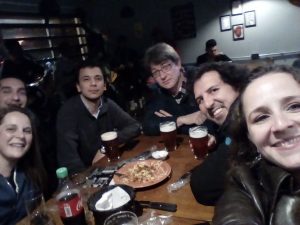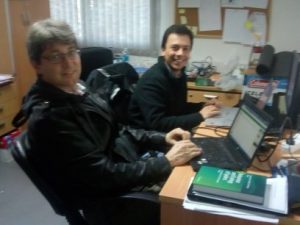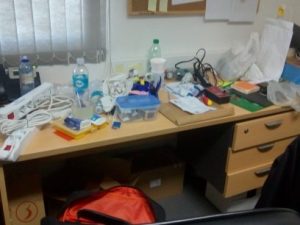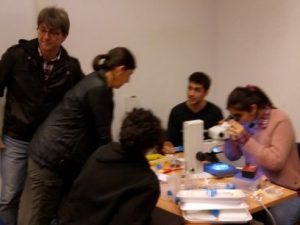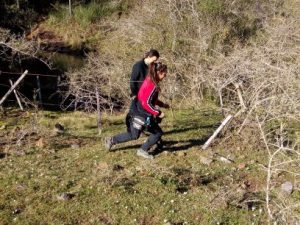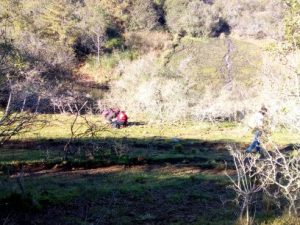Organization of the the Uruguay Lectures – Luis Fernando Garcia
The 2018 “Uruguay Lectures” in Rivera, Uruguay, were a very important academic event to come to South America for many reasons, among them the concept of putting in a bid for the 2022 (which became 2023 due to COVID) World Congress of Arachnology (which Uruguay was successful in attaining) was first discussed. The Springer book “Behavior and Ecology of Spiders” was launched in Rivera. More importantly it brought together students and researchers from across South America for one of the first times to learn about and discuss silk, spiders, biology, ecology, and other matters over beer, mate and plenty of pizza and beef. In this blog I speak with Luis Fernando Garcia-Hernandez from the Universidad de la Republic, Uruguay, in Trienta y Tres, who did a lot of the organizing of the lecture series and presented his work on spider silk, venom, ecology, and behaviour too.
SB: Hi Luis, I was really grateful to have the opportunity to present the silk lectures in Uruguay. It was an extremely unique experience personally and professionally. A magnificent long-term collaboration on all kinds of interesting projects has sprung from it. Can I ask you, however, Luis, for what reason was it decided that such a series of lectures should be held in Uruguay? Why Rivera? What were the educational and research objectives that the organizing team was trying to achieve?
LFGH: Thanks for your question Sean! When I first met you at Italy (at the European Arachnological Society Congress in 2014), I had the idea to cooperate with you and be able to make a long term collaboration in several aspects, specially developing local knowledge about spider silk. Fortunately, Uruguay is a country that makes this possible. Despite some limitations, the Universidad de la República and the country offer a great variety of tools to support international collaboration, so it provides an opportunity which is hard to get in other Latin American countries. In addition, the Universidad de la República is looking at expanding its presence in other parts of Uruguay, which are less developed academically like Rivera, so bringing courses like the one we offered, together opens a great opportunity for developing research areas and interest in other zones besides Montevideo.
I think that by the end of the course all our objectives were completed. We were able to bring one of the first courses for the study of silk in Latin America. We expanded the academic studies offered in a relatively new, opening, region like Rivera, and the most importantly we established a long term cooperation with you, which has allowed us to expand the local knowledge of arachnology, by boarding completely new topics.
SB: In a previous blog I spoke with David Chamé Vázquez, who was one of the students and I recalled the cultural experience we had and how it was more like a bunch of friends at a party than an educational course. How do you remember it?
LFGH: However, I think that being in a small space was very fruitful for students, as they could have an enriched exchange with you and all the other professors. This is not usual in other countries like Colombia, so I think for students it was a very motivating experience and we could notice this, as the performance of the students was very high! I think that by being in a small and familiar space, the students could learn a lot. The University in Rivera is experiencing a lot of changes now, however. It has bigger facilities and lot things have changed. The experiences we had will be unique forever. I honestly would love to repeat the experience! But it may not be possible.
SB: On a biological level, how do you find working in Uruguay. I personally found it to be absolutely amazing. I remember doing a field trip in the back yard of the university and finding silk-producing organisms and other critters all over the place. The place seemed to be heaving with them. How does the urban invertebrate life you saw, and still do, in Uruguay compare to that of Colombia?
LFGH: As a Colombian, I’m always proud of the Colombia’s megadiversity, In contrast to Uruguay, Colombia has many biomes, so urban life there changes a lot. You can find for example many weird spiders inside cities and that’s a big difference with Uruguay. This is an advantage and disadvantage at the same time for a course like the one we did, I think we would need several editions to cover the local Colombian diversity, which is still understudied in several aspects including silk.
SB: Geez Luis, we absolutely HAVE to do an educational or research program in Columbia sometime. It sounds absolutely amazing!
SB: One of the most interesting things I remember happening during a field trip was coming back from a collecting to find this enormous tarantula in a bottle on my desk, how did that come about?
LFGH: Well, some students were really interested in learning about tarantula silk properties, so we thought using it would be interesting to start working with it. As we sadly (and funnily) learnt some time after, working with tarantula’s silk is hard, so now it is a challenge but we expect to resolve this shortly, together, with you Sean!
On this, I note here that Luis has been collecting a whole heap of Tarantula silk for us from Columbia, and my collaborators Aditya Rawal and Jeffrey Yarger (each of whom I intend to interview in this blog sometime soon) are doing a great job at classifying them. More is to come on this.
SB: I also spoke to David about the devotion of the Uruguayan people to Maté and food, as well as football. This of course made the work in Rivera extra special. It was, of course, during the 2018 world cup so it was amazing for me as an Australian to be involved in. What was your take on the cultural activities in Rivera/Uruguay at the time?
LFGH: That’s completely true! Mate and soccer are a part of the Uruguayan culture. However, I must add that working in Rivera was a completely new experience. In my opinion most of Uruguay as a country, shares a lot of costumes with Argentina but this is not true in Rivera, which is strongly influenced by Brazil. Just like you may remember, Rivera is extremely close to the Brazilian city of Sant’ Ana do Livramento, so besides mate and soccer there are also lot of Brazilian costumes we could experience such as the “espeto corrido” where they have delicious meat!
SB:Yes they did. I miss those Sunday afternoon feasts. Is there somewhere where you would like to see a future similar lecture series be held? If that were to happen what would we expect?
LFGH: In my opinion, lectures were great, and my only hope is to be able to repeat and expand the course to other locations from Uruguay. I would like to cover some other topics about the study of silk study and may be in the future, Uruguay holds a lot of potential as a place to study and harness silk and other similar topics academically.
SB: I think we ought to seriously consider this idea Luis. There is, I think, potential for some commercial activities around silk and materials engineering and manufacturing in Uruguay and South America more broadly as well. We should talk about this and perhaps seek some funders soon. Maybe we can connect with some via this blog or other social media. If you’re out there, please touch base and leave a comment?
SB: I’m not sure if you’ve read my book, but what aspect of the lectures do you really remember, and is there a story/fact/myth about silk you wished the book had have covered?
LFGH: I bought your book and I have read it with great interest, but I have to finish it yet. In my opinion, I would like you to cover, for example, the use of silk in Pre-columbian South American cultures, as well as the current knowledge of silk study in Latin America.
Did you know that the spider was a deity for many Pre-columbian cultures, In Colombia for example, some cultures associate the web-building in some spiders with the hard work and also, have multiple local uses for the silk. It would be very interesting to explore the current view of silk/spiders by these cultures and how do they use it.
About the second topic, South American countries are often proud of the local mega-diversity. Interestingly we do not know a lot of this diversity and its potential use in several fields, this is the case for silk. By making a diagnosis of the silk knowledge in South America, we could promote the study of this interesting field locally.
SB: Yes these topics would be immensely interesting to write about, and I think I’d like to discuss with you what might be possible as a stand-alone publication on this, as well as constructing more on courses, expanding on those already delivered. I’d also love it if anyone reading could contribute any knowledge or ideas on this subject?
Thank you very much for the really fascinating chat Luis. I will be in touch for more as the post progresses.
For some perspective, here’s some photos taken by Luis that capture some of the activities that took place in Rivera in June-July 2018.
